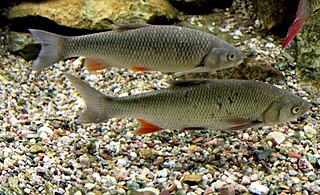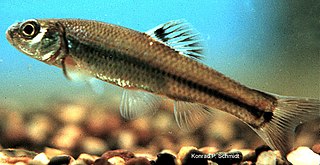
The common chub, also known as the European chub or simply chub, is a species of European freshwater ray-finned fish in the carp family Cyprinidae, that frequents both slow and moderate rivers, as well as canals, lakes and still waterbodies of various kinds.

The mummichog is a small killifish found along the Atlantic coast of the United States and Canada. Also known as Atlantic killifish, mummies, gudgeons, and mud minnows, these fish inhabit brackish and coastal waters including estuaries and salt marshes. The species is noted for its hardiness and ability to tolerate highly variable salinity, temperature fluctuations from 6 to 35 °C, very low oxygen levels, and heavily polluted ecosystems. As a result, the mummichog is a popular research subject in embryological, physiological, and toxicological studies. It is also the first fish ever sent to space, aboard Skylab in 1973.

The bluegill, sometimes referred to as "bream," "brim," "sunny," or, as is common in Texas, "copper nose", is a species of North American freshwater fish, native to and commonly found in streams, rivers, lakes, ponds and wetlands east of the Rocky Mountains. It is the type species of the genus Lepomis, from the family Centrarchidae in the order Perciformes.

The yellow perch, commonly referred to as perch, striped perch or preacher is a freshwater perciform fish native to much of North America. The yellow perch was described in 1814 by Samuel Latham Mitchill from New York. It is closely related, and morphologically similar to the European perch ; and is sometimes considered a subspecies of its European counterpart.

The spoonhead sculpin is a species of freshwater ray-finned fish belonging to the family Cottidae, the typical sculpins. This species is widespread in northeastern North America.
The blue chub is a cyprinid fish found in the Klamath River and Lost River drainages of far northern California and southern Oregon.

The longnose dace is a freshwater minnow native to North America. Rhinicthys means snout fish and cataractae means of the cataract. Longnose dace are small, typically less than 100 mm and characterized by their fleshy snout that protrudes past the mouth. They are well adapted for living on the bottom of fast-flowing streams among stones. Longnose dace eat algae and aquatic insects and are important forage minnows for larger predatory fish.

The emerald shiner is one of hundreds of small, silvery, slender fish species known as shiners. The identifying characteristic of the emerald shiner is the silvery emerald color on its sides. It can grow to 3.5 inches in length and is found across North America from Canada to the Gulf of Mexico, commonly in large, deep lakes and rivers, though sometimes in smaller bodies of water as well. It feeds on small organisms such as zooplankton and insects, congregating in large groups near the surface of the water. It is a quite common fish and is often used as a bait fish.

The northern hogsucker is a freshwater ray-finned fish belonging to the family Catostomidae, the suckers. It is native to the United States and Canada where it is found in streams and rivers. It prefers clear, fast-flowing water, where it can forage on the riverbed for crustaceans, mollusks, aquatic insects, algae and detritus. It turns over small pebbles and scrapes materials off rocks and sucks up the particles, and other species of fish sometimes station themselves downstream from its activities so as to garner disturbed food fragments. Breeding takes place on gravel bottoms in shallow riffles in late spring. This fish is susceptible to such man-made disturbances as channelization, sedimentation, pollution, and dam construction. However, it has a wide range and is a common species so the International Union for Conservation of Nature has rated its conservation status as being of "least concern".

The hornyhead chub is a small species of minnow in the family Cyprinidae of order Cypriniformes. It mainly inhabits small rivers and streams of the northern central USA, up into Canada. The adults inhabit faster, rocky pools of rivers.

Semotilus atromaculatus, known as the creek chub or the common creek chub, is a small minnow, a freshwater fish found in the eastern US and Canada. Differing in size and color depending on origin of development, the creek chub can usually be defined by a dark brown body with a black lateral line spanning horizontally across the body. It lives primarily within streams and rivers. Creek chubs attain lengths of 2-6 inches with larger specimens of up to 12 inches long.

The pugnose shiner is a species of ray-finned fish in the genus Notropis. It is in the family Cyprinidae which consists of freshwater carps and minnows. Cyprinidae is the largest fish family which consists of about 369 genera and 3,018 species. Its distribution has been decreasing due to the removal of aquatic plants in order to create swimming beaches and boating access in freshwater lakes and is now mostly found in Minnesota, Wisconsin, and Michigan.

The ironcolor shiner is a species of freshwater ray-finned fish from the family Cyprinidae, the minnows and carps. It is a widespread species in streams and rivers in eastern North America.

The speckled chub is a species of freshwater fish in the family Cyprinidae of the order Cypriniformes, which also includes carps, suckers, and loaches.
The silver chub is a species of freshwater fish of the family Cyprinidae found in North America.
The river chub is a minnow in the family Cyprinidae. It is one of the most common fishes in North American streams.

The pugnose minnow is a species of cyprinid fish found in the eastern North America. There are two recognized subspecies with the subspecies from Florida recognized as race peninsularis.

The bullhead minnow is a species of freshwater demersal fish, native to the Mississippi River system in the United States, to tributaries of Lake Huron and Lake Michigan and to northern Mexico.

Mylocheilus caurinus, the peamouth, peamouth chub, redmouth sucker or northwestern dace, is a species of freshwater ray-finned fish from the family Cyprinidae, the carps and minnows, that is found in western North America. It is the only species in its genus.

Whether fish sleep or not is an open question, to the point of having inspired the title of several popular science books. In birds and mammals, sleep is defined by eye closure and the presence of typical patterns of electrical activity in the brain, including the neocortex, but fish lack eyelids and a neocortex. Some species that always live in shoals or that swim continuously are suspected never to sleep. There is also doubt about certain blind species that live in caves.


















